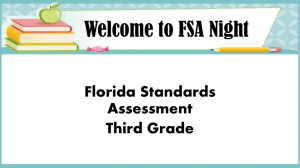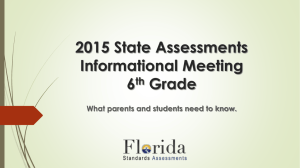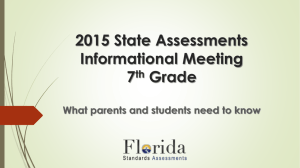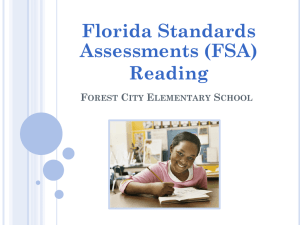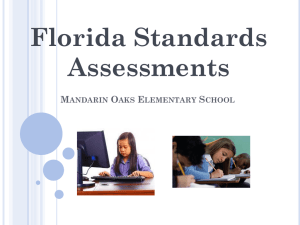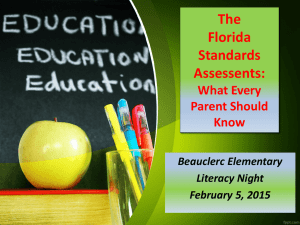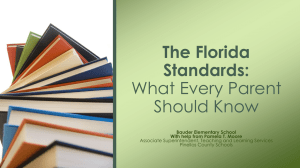Elem_Essentials 2-6-15 V06 - Palm Beach County Schools News
advertisement
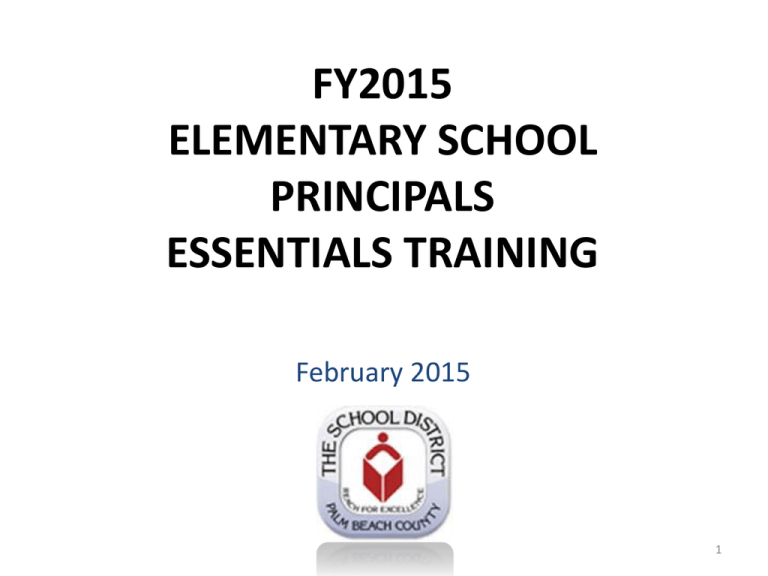
FY2015 ELEMENTARY SCHOOL PRINCIPALS ESSENTIALS TRAINING February 2015 1 • • • • Agenda Introductions Accountability Framework and Timeline Essential Questions Curriculum Support – Literacy • Resources and Support • Data Reports • Action planning – Mathematics • Resources and Support • Data Reports • Action planning – Science • Resources and Support • Data Reports • Action planning • Close 2 Assessment and Accountability Transition Spring 2014: FCAT 2.0 Administered Spring 2015: New Florida Standards Assessment (FSA) administered 2013-2014 Summer 2014: School Grades released with current formula and accountability measures Summer 2015: Standard setting begins to establish cut scores for the FSA 2014-2015 Spring 2016: FSA administered for the 2nd time 2015-2016 Fall 2015: Baseline School Grades released based on FSA results and new cut scores Summer 2016: School Grades released with consequences 3 FDOE Assessment Standard Setting Process Achievement Level Descriptions (ALDs) Legislative Review Educator Panel Commissioner’s Recommendations/ Proposed Rule Reactor Panel Public Input Workshops State Board of Education 4 FDOE Assessment Standard Setting Timeline Month/Year Spring 2015 April – May 2015 August 2015 September 2015 Winter 2015 Task Draft Achievement Level Descriptions for the Florida Standards Assessments Administer baseline assessments Conduct standard setting meetings, including “reactor” meetings with business leaders, educational administrators and other citizens Conduct rule development workshops and seek input from the Florida legislature State Board of Education rule adoption – new Achievement Level cut scores for the Florida Standards Assessments 5 Accountability Development Process 6 Accountability Development Process 7 FY2015 Elementary School Grading Model ENGLISH/ LANGUAGE ARTS MATHEMATICS SCIENCE ACHIEVEMENT (0% TO 100%) ACHIEVEMENT (0% TO 100%) ACHIEVEMENT (0% TO 100%) LEARNING GAINS: OVERALL (0% TO 100%) LEARNING GAINS: OVERALL (0% TO 100%) LEARNING GAINS: LOW 25% (0% TO 100%) LEARNING GAINS: LOW 25% (0% TO 100%) Grade based on % of Total Points Earned (700) Key Differences • Schools will only be graded on the components for which they have 10 students – Schools that don’t have enough data for one or more components will still receive a grade • Learning Gains require students – scoring below grade level to grow toward grade level – already at grade level to progress beyond grade level 9 Key Differences • English Language Arts – Grades 3-5 – Includes Writing (No stand alone Writing Score) • ELL students included after 2 years • No extra weighting or penalties • School Grade based on the percentage of total points earned • Grade 3 ELA Scores: Levels tied back to 2014 • Other FSA Tests: T-scores and Percentile Ranks 10 FSA Training Tests • Content-specific practice tests http://www.fsassessments.org/training-tests • Familiarize students –Item types –Tools available • Trackpad or Mouse Assessment: Improving Student Achievement • Develop Essential Questions • Review Assessment Data – Fall, Winter Diagnostic – FSQs, Semester Exams, other • Review Teaching and Learning – Alignment and Rigor – Student Work and Teacher Feedback • School-Based Action Plan for Improving Achievement 12 Essential Questions Assessment Data • Which standards have/have not been instructed? • How does our overall performance compare to the District? • Standards where students perform best? • Standards where weaknesses are evident? • How are different groups performing by standard? • How can we group students by needs? • Are there specific gaps in skills for a group of students? 13 Essential Questions Teaching and Learning • To what extent do teachers understand, teach to, and assess the standards at a consistent and appropriate level of rigor? • Are standards, assessment, and instruction aligned? • Are specific reading and math interventions improving literacy skills for selected students? • What instructional strategies appear to be effective? • By what criteria are we evaluating student work? • To what extent do all teachers and students receive the ongoing assistance they may need? 14 Action Planning FLORIDA STANDARDS ENGLISH LANGUAGE ARTS (ELA) What data was reviewed? What are we doing well? What do we need to improve? What is our plan for improvement? How will we monitor our plan? Grade 3 Grade 4 Grade 5 Tutorial 15 CURRICULUM RESOURCES AND SUPPORT 16 Elementary Literacy Essentials English Language Arts (ELA) (Summary) • Test Sophistication Unit (TSU) • • • • Planning Cycles completed ~ Teachers Assistant Principal TSU Overview (1/27/15) Principal TSU Overview (1/8/15 & 2/5/15) Schedule your staff developer for support • • • • • Push in classroom support: modeling, coaching, feedback, etc. LTMs Grade level meetings Before/after school Available throughout the day for teachers during fine arts • Additional Student Practice Items (Test Item Types) will be provided based on recent information received from the FSA Portal Test Sophistication Unit “Look-Fors” (Reading) Test Sophistication Unit “Look-Fors” (Writing) Test Sophistication Unit (TSU) Reminders Reading Both Writing • Read alouds: outside of block/through other content areas • Use previous anchor charts • Students engage in ongoing editing • Shared reading: every day; help students accumulate strategies taught across the weeks • Students need to be able to read and respond to grade level text • Students use reading passages to practice open response – collaboration between reading and writing teachers should occur • Students continue to read independent level books daily (build stamina and volume) • Teachers continue to support students through small group instruction • Students need long stretches of writing time to simulate assessment (build stamina and volume) • Students work in partnerships. • Students code text and make marginal notes • Student passages and other resources on Learning Village • www.FSAssessments.org (FSA Portal) Tested Standards Taught in Units of Study #1-3 PERFORMANCE MATTERS REPORTS 23 Getting Started • Access from District Portal • Google Chrome • Use .RPT assessments – .RPT-PB_WINT_FSA_DIAG_MA_GR5 • Refer to Quick Guides and Videos for support Videos and PDFs 24 Data Analysis Reports Report Description Executive Director Comparative Results Item Analysis Quick overview of test performance by teacher, by class, by subgroup Compare teacher performance by standard to school, district on 1 test or many Analyze performance by item, by standard Baseball Card Customized reports to analyze 2 or more tests, standards, share a link 25 Executive Director’s Report • Teacher overall performance –By Class, Subgroup • Compare to –Standard, Self, Others Area, District 26 Executive Director’s Report 1 2 3 27 Executive Director’s Report 1 2 3 28 Executive Director’s Report Teacher Teacher Teacher 29 Comparative Results Report • Teacher performance by Standard across tests • Compare to –Standard, Self, Others School, District 30 Comparative Results Report 1 2 3 31 Comparative Results Report 1 2 3 32 Comparative Results Report Item Analysis Report • Performance by Item • Performance by Standard • Distractor Analysis –Compare to District • Strength & Weakness 34 Item Analysis Report 1 2 3 35 Item Analysis Report 36 Item Analysis Report Item Analysis Report Baseball Card Report • Custom build reports • Compare across test/standard • Create aggregate summaries • Export or Link 39 Baseball Card Report 2 1 40 Baseball Card Report Download or Share Link 41 Action Planning FLORIDA STANDARDS ENGLISH LANGUAGE ARTS (ELA) What data was reviewed? What are we doing well? What do we need to improve? What is our plan for improvement? How will we monitor our plan? Grade 3 Grade 4 Grade 5 Tutorial 42 Break 15 Minutes 43 Elementary Mathematics Essentials FSA Resources for Grades 3-5 • Mathematics instruction of the MAFS with depth will support FSA preparation. • Alignment charts and instructional resources are provided on Learning Village Domain Resources page Standards Focus Questions • 3 Questions for each standard • Multiple item type formats (per Test Item Specs) • PowerPoint Slides with solutions • PDF version for students to complete on their own Standards Focus questions Winter Diagnostic Grade 4 PERFORMANCE MATTERS REPORTS 52 Action Planning FLORIDA STANDARDS Mathematics What data was reviewed? What are we doing well? What do we need to improve? What is our plan for improvement? How will we monitor our plan? Grade 3 Grade 4 Grade 5 Tutorial 53 Grade 5 Science Winter Diagnostic Data Category District % Correct Notes Nature of Science 62% Most improved Earth and Space 62% Consistently high scoring Physical Science 56% Area of focus Life Science 47% Area of concern • Only 12 questions scored below 50% and 6 of them were 3rd and 4th grade “fairgame” benchmark test items. • All test items scoring below 30% proficiency were “fairgame” benchmarks. • Lowest scoring test items= 3rd grade Life Science Recommendations for Instruction • Implement vertical planning and hold all grade levels accountable for standards-based science instruction (utilize Learning Village resources). • Integrate science into reading and writing while maintaining a daily block of science instruction for essential hands-on learning. • Appoint a science contact and/or coach who will attend district meetings to improve communication and the flow of valuable science resources to your learning community. • Take advantage of the science curriculum team’s school-based customized professional development. * Learning Village has been updated with new and improved resources that target student needs (based on teacher feedback and the changing instructional environment). Please encourage your K-5 teachers to re-visit their grade specific science landing pages and become familiar with the new resources. SCIENCE PROFILE REPORT 58 Action Planning Next Generation Sunshine State Standards Science What data was reviewed? What are we doing well? What do we need to improve? What is our plan for improvement? How will we monitor our plan? Grade 3 Grade 4 Grade 5 Tutorial 59 CLOSING 60
